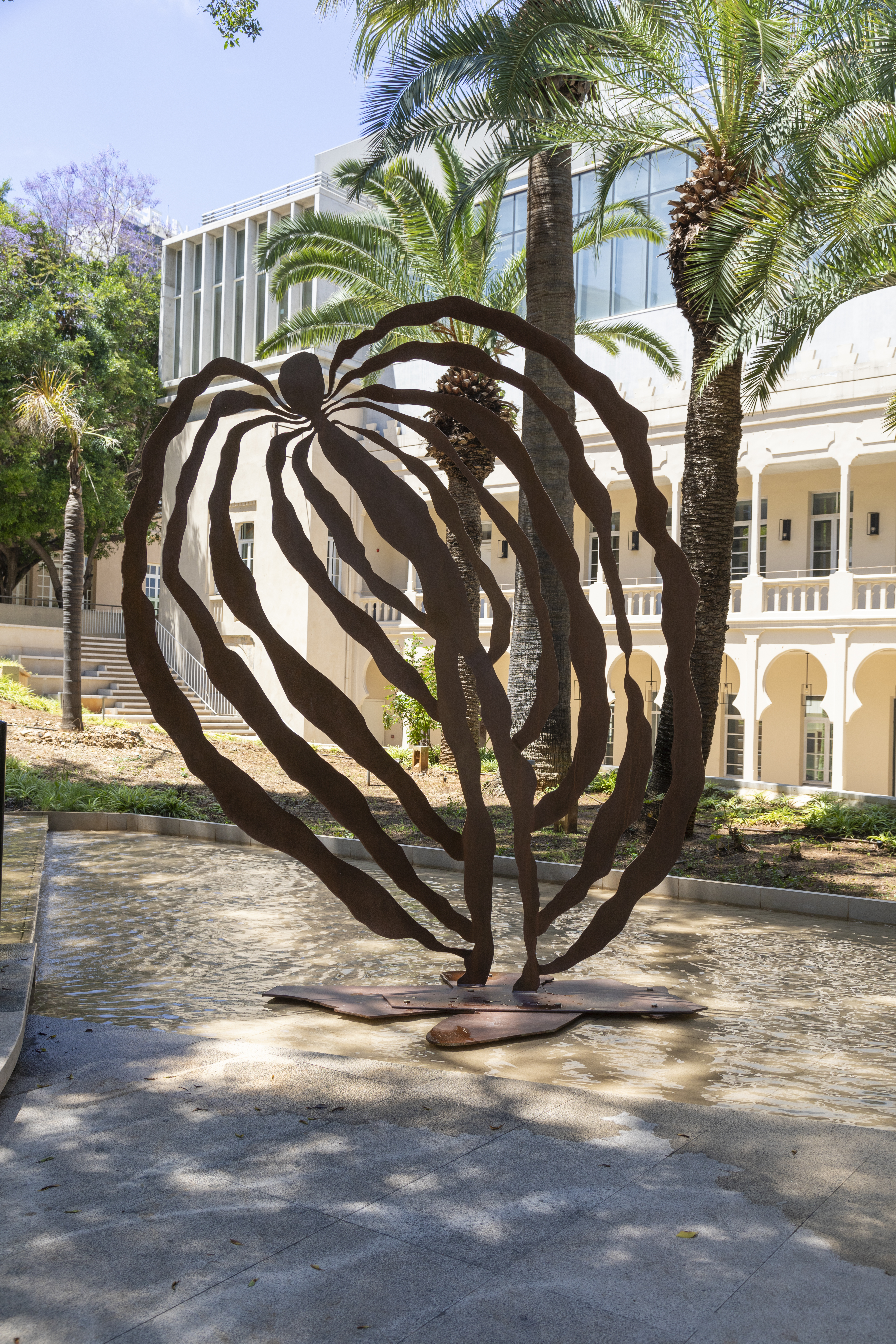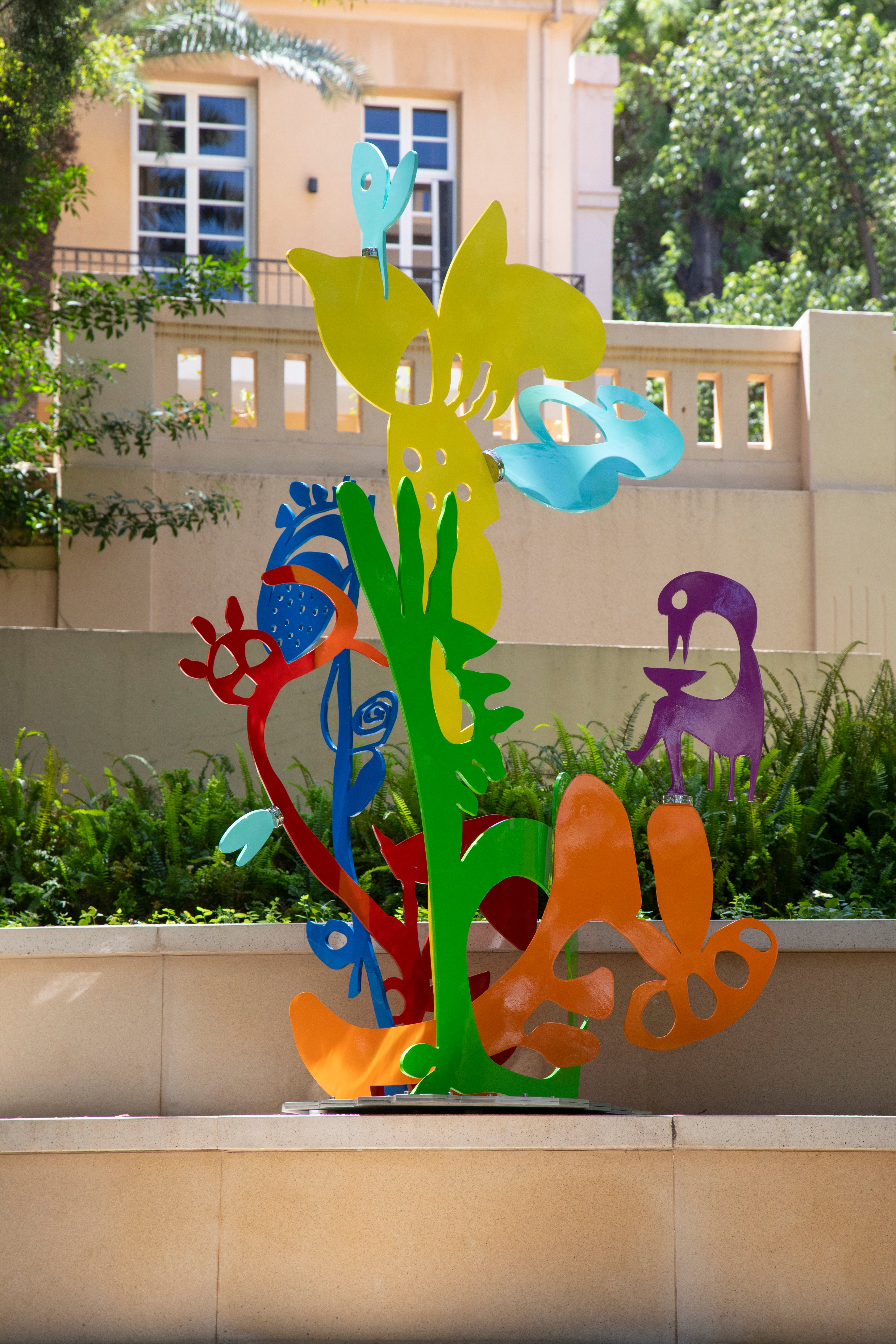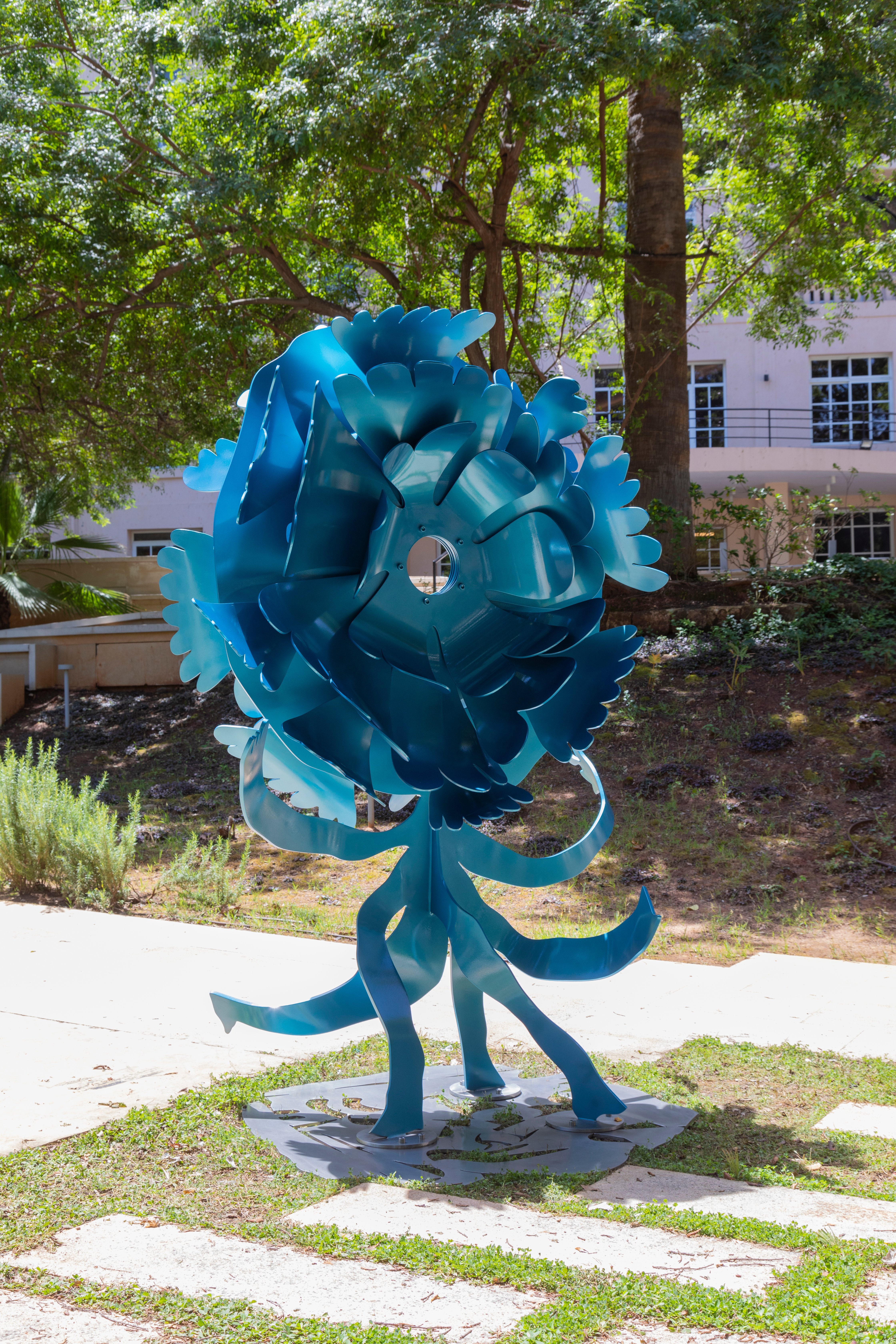
"Hold Me," a rusted iron sculpture by Nadim Karam depicting two people in an embrace. (Credit: Elie Bekhazi)
Beirut first encountered Nadim Karam in 1994 at the Sursock Museum, as part of a project titled “T-Races BSC-4971.” The project featured a collection of moving figures, neither human nor animal, that looked, walked, ran and danced. The hybrid creations, strange and absurd, oscillated between happiness and melancholy.
A keen traveler, Karam has exhibited his art all over the world. His work, inspired by his visits to France and Japan (among other places, inexorably draws him back to his homeland. His 30-year career is anything but conventional.
Karam’s works, often focused on public spaces, invite viewers to question the socio-political issues inherent in public art, solidifying his status as a marginal artist.
His distinctive visual language allows him to explore the intersection of spaces, memories and human experiences.
 Nadim Karam's "Layers Untold" illustrates the successive layers of things left unsaid. (Credit: Elie Bekhazi)
Nadim Karam's "Layers Untold" illustrates the successive layers of things left unsaid. (Credit: Elie Bekhazi)
“Vie sur vie” is the title of Karam’s new exhibition at the Henry and Nadège Obegi Gardens of the ESA Business School in the Clemenceau sector of Beirut.
Here, monumental sculptures question the interconnection between two series of works: “To Be or Not to Be” and “Urban Bouquets,” in which the artist explores existentialism through a humanist lens tinged with absurdity.
The materials and compositions of the works in “To Be or Not to Be” suggest that at the heart of the existential struggle lies an opportunity to find meaning in the forces that disturb us.
Meanwhile, the “Urban Bouquets,” composed of flowers arranged on a base with multiple removable hexagons from which stems, birds or other modular elements emerge, offer a necessary respite from the weight of urban realities and bring nature into proximity.
The human condition
The human condition has always been at the heart of Karam’s work. It permeates all the themes he tackles: From migration to war, through life and death that coexist in a region where tensions are legion and inevitably lead to a predominant need for survival.
The Aug. 4 Beirut port explosion, which destroyed his flat, certainly added to his story.
Since “The Gesture,” his monumental sculpture at the port of Beirut erected in memory of the victims of the explosion, “Vie sur vie” is the first exhibition to showcase work produced after that pivotal date.
It follows “Journal of Present Times,” a retrospective exhibition held at the Arboyan factories earlier this year. It shows that the artist has taken the time to recompose himself, transforming his pain and questions into works of art that, in turn, speak to the viewers.
 A bouquet of colorful sculptures in the gardens of the École supérieure des affaires in Clemenceau. (Credit: Elie Bekhazi)
A bouquet of colorful sculptures in the gardens of the École supérieure des affaires in Clemenceau. (Credit: Elie Bekhazi)
“I began to work differently, to transform this giant abyss, to sculpt my life to accept it and compensate for all the horrors we are still experiencing today,” Karam told L’Orient-Le Jour.
The two series, “To Be or Not to Be” and “Urban Bouquets,” which seem at first sight to be opposed in terms of both materials and colors, actually invite dialogue and decipher the underlying relationship between nature and conflict and chaos, where each encounter becomes a new possibility.
“If the audience identifies with the message I’m trying to express, that’s already very important to me,” said Karam, who chose heavy, rusty iron planks that he entrusted to local craftsmen. The craftsmen manipulated and bent the steel as they saw fit, to “give it a lightness that veers towards the fragility of life,” he explained.
“Hold Me,” “In the Balance,” “Inner Struggle” and “Crybabycry” are just some of the names of these rust-colored works, which stand in stark contrast to “Blooming Great” in blue, the color of hope and a symbol of rebirth, or “Gen Z” in sunny yellow, dedicated to a youth he describes as anguished. A little further on, “Am I” is dressed in red and explores identity, a vast subject in our time, all set against flower bouquets sparkling with color and happiness.
“Talking to the works and having them respond in one way or another to each of us… What’s important are the new questions that arise at each new stage of life,” said Karam.
He invites the viewers to decipher these lives, where the accumulation of tragic and sad emotions forces us into permanent survival, but also serves as sources of creativity and hope, expressing the inherent Lebanese people’s “joie de vivre.”
 "Blooming Great," a beautiful blue bloom in the ESA gardens at Clemenceau. (Credit: Elie Bekhazi)
"Blooming Great," a beautiful blue bloom in the ESA gardens at Clemenceau. (Credit: Elie Bekhazi)
Karam’s complex work in “Vie sur vie” remains accessible to everyone, “because these are Beirut sculptures that draw on the dexterity of local craftsmen, making it easy to grasp the message of the work without necessarily putting it into words,” he said.
“‘To Be or Not to Be’ is adapting to the idea that we simultaneously exist and don’t exist, and from the permanent imbalance that we undergo, we can achieve a certain form of serenity. It’s not easy, but we are obliged to try. It’s a way of living, of accepting this human condition,” he added.
Karam’s deepest wish is to inspire the towns and cities where he would like to arrange bouquets much larger than those in “Vie sur vie,” especially after the Covid disaster that struck humanity and the conflicts that erupted everywhere.
“We’ve all needed colors, butterflies and birds to refresh us a little and make us want to escape,” he said.
“Vie sur vie” will run until July 26, 2024, at the Henry et Nadège Obegi Gardens at the ESA Business School.
This article was originally published in L'Orient-Le Jour, translated by Sahar Ghoussoub and edited by Yara Malka.

